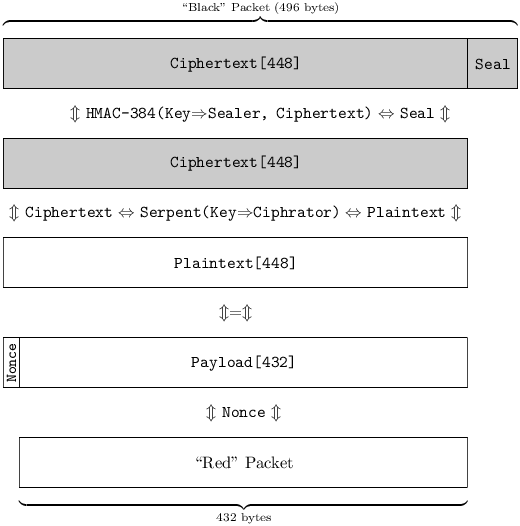Pest: Specification
| Author | Stanislav Datskovskiy (WOT: asciilifeform) |
| Version | 0xFA |
| V Tree (Previous Drafts) |
pest_spec.kv.vpatch (sig) pest_spec_FE.kv.vpatch (sig) pest_spec_FD.kv.vpatch (sig) pest_spec_FC.kv.vpatch (sig) pest_spec_FB.kv.vpatch (sig) |
| About | This is a mirror of asciilifeform's Pest spec, currently at version 0xFA (latest draft here). |
| Join | If you want to join but aren't sure where to begin you can drop into the Discord <=> Pest bridge, maintained by thimbronion (WOT: thimbronion), and ask for help in setting up your own Pest station. Any messages you write in the chat will be automatically broadcast in the inaugural pestnet via the discord_bridge bot. |
| Contribute | If you are interested in contributing or providing feedback you can do so by leaving a comment on the original article or by joining #asciilifeform on dulapnet. You can also follow along with the discussion by reading the pestnet logs (also available here). |
- 1 Why Pest?
- 2 The Philosophy of Pest: The Three “Nothings”.
- 3 Pest Station Basics.
- 4 The Pest Transport Protocol.
- 5 The Pest
Message. - 6 Operator Console
- 7 Rekeying
- 8 NAT Penetration
- A Appendix.
1 Why Pest?
Pest is a peer-to-peer network protocol for secure real-time communication1 between mutually-consenting parties. It is designed for decentralization of control, obstruction of eavesdropping and traffic analysis, resistance to natural and artificial interference, and mechanical simplicity – in that order.
1.1 Exodus from IRC, and Resisting “User Domestication”.
Pest was originally devised in reaction against the odiously centralizing design of IRC. An IRC relay is typically inhabited by a multitude of casual users, who cannot communicate directly2 with one another, and interact via the relay strictly at the mercy of a small group of administrators. The latter typically oversee a network of such relays, and determine which users may log in, use particular handles, create and manage particular channels, etc. and may temporarily delegate this authority to others.
The typical outcome of any conflict between IRC users and administrators is the expulsion of the former from the network. Even when a dispute reaches a boiling point and users begin to “emigrate” en masse, any refuge they may choose is quickly found to resemble the place from which they escaped – whether they move to another IRC network, or start a new one where the “rebels” immediately take their own turn as “tyrants” over a fresh crop of powerless users. And often enough, the escapees take to using commercial chat services – dispensing with IRC’s threadbare imitation of decentralization entirely.
Interestingly, IRC suffers from a design defect which makes true decentralization impossible even if every user were to operate a personal relay: the protocol’s intolerance of cyclic routing requires relays to be arranged in a tree topology, where every well-connected participant is a central point of failure. IRC offers relay operators no defense against denial-of-service3 attacks; but even in the absence of attacks, its acyclic networks are fragile. Their frequent net splits make reliable logging of public conversations difficult, further helping commercial chat service providers to lure away IRC users.
On top of this, IRC makes no provisions for secure end-to-end communication, or in fact for any kind of censorship resistance whatsoever – the protocol trivially lends itself to detection and inspection en route, and ISPs have been known to block it. Commercial chat services increasingly market themselves with misleading, or outright false (but impressive to nontechnical audiences) claims concerning privacy and censorship resistance. In every case, their actual objective is user domestication – any commercial entity’s claim to decentralization4 is nothing more than bait for the gullible and the desperate.

1.2 How Pest Differs from IRC and Other Chat Protocols.
In contrast to an IRC relay or a commercial chat server, a Pest station is inhabited by exactly one user: its operator. It sends and receives authenticably-encrypted UDP packets, communicating exclusively with an operator-selected set of peer stations known as its WOT (web of trust.) Each of these stations, in turn, may have its own set of peers, ad infinitum, forming a fully-decentralized net with unrestricted connection topology.
Pest does not rely on any centralized Internet services (in particular, it does not use DNS, NTP, or the master-keyed pseudo-cryptography of SSL) and offers resilience to communication disruptions, as well as compatibility with ad-hoc alternatives to traditional Internet connectivity.
The simplicity of the Pest protocol allows for multiple independent, interoperable implementations. Writing a working Pest client ab initio does not require knowledge of university-level mathematics. Neither does it demand the use of bulky (and invariably bug-ridden) cryptographic libraries.
1.3 Pest Nets.
Pest stations organize into nets. A net is formed by a group of station operators with a common interest. An operator who wishes to join a net must peer with at least one existing station in that net. Nets may easily and organically combine into larger nets, or, on the contrary, undergo schismatic splits, whenever the individual station operators so desire.
1.4 Identity is Decentralized.
A prospective Pest station operator does not need to ask permission from anyone; and the only other people who will need to know about the mere existence of the station will be its peers. To join a Pest net, an operator must simply find one or more current members of that net who would like to peer with his station, and securely exchange5 a small amount of information to establish the peering. An active Pest station may have as few as one peer, or as many as its hardware is able to service at the desired bandwidth capacity.
A Pest station operator may choose any handle he likes, so long as it does not collide with that of a peer. Importantly, one person may easily operate multiple Pest stations, and inhabit multiple disjoint nets; and may use, if he wishes, a different handle on each net.
1.5 Station Operator is Answerable Only to Peers.
Unlike IRC or commercial chat services, Pest does not impose a hierarchical structure of control, and therefore offers no direct equivalents to IRC’s "kick" and "ban". Instead, an annoying, tedious, or habitually-spamming station operator may be rebuked by his peers; if he persists in his misbehaviour – ignored via Usenet-style killfiles; and, if he proves incorrigible – unpeered. Sooner or later, the malefactor will find himself where he belongs: either alone or in the company of his own kind.
1.6 Unrestricted Network Topology.
Pest broadcasts are flood-routed – i.e. they traverse all available propagation paths. Unlike IRC relays, Pest stations may be connected in any topology their operators prefer; concretely, loops are permitted, in the interest of decentralization. Packet storms are prevented via deduplication at the station level – rather than by prohibiting loops, or via a spanning tree protocol, or any other traditional routing schemes which enforce acyclic connection graphs by demanding the existence of "root nodes", "supernodes", centrally-imposed precedence tables, etc.
Pest station operators are not merely permitted, but in fact encouraged to form richly cyclic connection graphs for the highest attainable resiliency.
1.7 Connectionless and Medium-Agnostic.
Every Pest Message travels in an individual authenticably-encrypted packet. The receiver of a packet determines the identity of its sender strictly by attempting Seal verification against each of the Keys in his WOT, in random order6. If and when a Seal verification succeeds, the packet is attributed to the peer whose Key verified it, and the Message is decrypted and processed.
A Pest station is able to quickly reject malformed, spurious, corrupted, or duplicate incoming messages. At the same time, the address fields provided by the IP protocol are not used in the validation of a Pest packet. Consequently, Pest traffic may be easily and safely carried over an otherwise-unsecured and “addressless” shared-everything medium, such as radio, or via several conventional Internet connections operated in tandem7.
Pest Messages carry hashes of their predecessors to enable detection of loss in transit and allow for retransmission requests. As a result, Pest is insensitive to connectivity disruptions (whether planned, accidental, or malicious), and Pest traffic may be carried reliably over lossy channels (radio, poor-quality or short-lived Internet connections, etc.)
2 The Philosophy of Pest: The Three “Nothings”.
Pest is designed around the intent of “cutting off the oxygen” to three species of vermin: the stranger – who brings DDOS and spam; the snoop – who steals “anything not bolted down”; and the snitch – who betrays trust.
2.1 “Nothing to the Stranger.”
From a Pest station’s point of view, a stranger is any Internet-connected machine other than a current WOT peer. This category includes former peers, as well as members of Pest nets disjoint from the given station’s. Unlike virtually all traditional Internet protocols, Pest does not talk to strangers. At all.
Strangers may, of course, send arbitrary packets to anywhere at all – including a Pest station. However, because a stranger (by definition) does not possess any of the Keys in that station’s WOT, all such packets will be deemed bogus and immediately discarded. A bogus packet will not trigger any kind of response from a Pest station.
A stranger who somehow comes across a packet previously sent to a Pest station by one of its peers, and retransmits copies of it to that station (“replay attack”) will not succeed in flooding the station or its net with garbage or exhausting the station’s machine resources: such a packet will be inexpensively determined to be a duplicate or stale and discarded as bogus.
A bogus8 packet is one which the receiving station identifies as martian, malformed, duplicate, or stale. Such packets are silently discarded. Conversely, packets which are found to be neither martian, malformed, duplicate, nor stale are considered valid, and will be processed by the station in the order in which they were received.
2.1.1 “Martians”.
An incorrectly-sized9 packet received by a Pest station – or a correctly-sized one which does not bear a valid Seal from one of its peers is referred to as a martian. All such packets are silently discarded.
2.1.2 Malformed.
An incoming packet carrying a Message which violates a formatting rule is referred to as malformed. All such packets are silently discarded.
2.1.3 Stales.
Any packet bearing a Message which has expired, or appears to come "from the future" is deemed stale and – even though it may be valid in every other respect – silently discarded10.
2.1.4 Duplicates.
An incoming packet which is found to be neither martian nor stale may be deemed a duplicate if the Message it bears is found to be identical to one encountered in any previously-received valid packet. Duplicates are silently discarded.
2.2 “Nothing to the Snoop.”
A stranger who is able to capture some or all of the packets entering or leaving a Pest station is referred to as a snoop.
2.2.1 No Plaintext Fields in Pest Packets.
Pest packets traveling between stations contain no unencrypted information whatsoever11 – and in particular, feature no "magic numbers" or other fields with meaningful or predictable values of any kind which could identify them to a third party as Pest packets or reveal any information at all concerning their Payloads to anyone lacking the requisite Key.
Consequently, a Pest packet intercepted en route conveys no useful information to a snoop, apart from the mere fact that a particular machine had sent a string of 496 apparently-random bytes12 to a certain other.
2.2.2 Chaff.
In the interest of thwarting traffic analysis, a Pest station will occasionally transmit rubbish packets – indistinguishable, to a snoop, from other Pest traffic – to peers, or even to randomly-generated IP addresses.
Additionally, a station may occasionally transmit copies of a packet keyed for a given addressee to one or more randomly-selected other peers, in random order. All recipients other than the intended addressee will harmlessly reject the martian; while the task of a snoop charged with determining "who is talking to whom" becomes rather unenviable.
2.3 “Nothing to the Snitch.”
If you give me six lines written by the hand of the most honest of men, I will find something in them which will hang him. Cardinal Richelieu.
In the context of Pest, a snitch is a traitor or infiltrator who would divulge to a third party some information he had been given in confidence by one of his Pest peers – in an attempt to implicate the latter in a “thoughtcrime” or scandal, or otherwise tarnish his reputation.
2.3.1 Pest Messages are Authenticable, but not Opposable.
All Pest Messages are authenticable – a station will only process an incoming message if it carries a valid Seal (i.e. signature) from a peer. However, they are also repudiatable (i.e. non-opposable). Seals are produced using symmetric cryptography – a peering Key is exactly the same on both sides of a peering. Therefore, a snitch cannot, at any point in time, prove to anyone that he was not himself the author of a message he may claim to have received.
2.3.2 Caveats.
- Even though all traffic between Pest peers is encrypted, a Pest broadcast should usually be thought of as public speech – its originator can have no certain knowledge of where it may eventually propagate to. You may know your peers well, but how well do you know all of their peers? The same is true of a direct message sent to someone with whom you do not have a strong relationship of trust.
- A Pest hearsay should be thought of as a rumour – it may originate from virtually any participant of a given Pest net, and may claim to have been authored by virtually anyone.
- A traitorous or incompetent peer may expose your shared peering
Keyto third parties, and consequently his side of the peering may begin to suffer from “multiple personality disease”. Do not hesitate to unpeer him! - Peering
Keys are only as secure as the devices they are stored in. Remember that anyone who succeeds in stealing aKeywill be able to impersonate either side of the peering defined by thatKey. Avoid exchanging Pest keys in public places or via unsecured communication channels. (Use e.g.GPG.) Beware of shared hosting services which may expose your keys to snoops. - If you end up revealing a genuinely valuable secret to a traitor, the gods themselves cannot save you!
3 Pest Station Basics.
The operator of a Pest station – who may be a human or a bot – has absolute control of the station and its configuration. A station communicates exclusively with:
- The operator – via the operator console.
- An operator-selected set of remote peer stations – via ciphered and signed
UDPpackets.
3.1 Peers and Keys.
In order for a pair of Pest stations to communicate, their operators must decide to peer them by agreeing on a shared secret Key. Every packet sent by one peer to the other is enciphered and signed by the sender, and will be verified and deciphered by the receiver using this Key.
Additionally, the peers must establish one another’s reachable Addresses. If one or both of them has a routable, static public IP, this may be accomplished via the AT Command; otherwise it will take place automatically, supposing both of the peers are able to reach a given net.
If, at some future time, the operator of either station no longer wishes to continue in this relationship, he may terminate the peering unilaterally, and the two stations will then be said to have unpeered. A former peer is treated exactly the same as any other stranger.
3.2 The WOT.
A Pest station may have any number of peers. One or more13 known Key for each peer is kept in a data structure referred to as the station’s WOT. The operator may alter this structure at any time, and changes take effect immediately. The WOT is never altered by the station except by direct command of the operator. Each peer entry in the WOT also contains one or more Handles known to be in use by the peer.
3.3 The AT.
A Pest station has another data structure, the AT (Address Table), which holds the last known reachable Address of each WOT peer. The AT is used exclusively for determining where to send outgoing packets.
Like the WOT, the AT may also be altered by the operator at any time. Unlike the WOT, the AT is automatically updated by the station when a packet attributed to a given peer is received from a new (i.e. not currently in the AT entry for that peer) Address. The AT holds one entry per WOT peer.
4 The Pest Transport Protocol.
4.1 Packets.
4.1.1 Black Packet.
All Pest network traffic without exception consists of black14 packets. Every black packet is precisely 496 bytes long15, and consists of a 448-byte Ciphertext followed by a 48-byte Seal:

Such a packet is easily authenticated and deciphered by its intended addressee, but entirely meaningless to snoops – who, by definition, lack the Key against which the Ciphertext and Seal were created, and therefore cannot decipher or authenticate the packet, distinguish it from random noise, or craft a plausible – in whole or in part – spurious replacement.
4.1.1.1 Ciphertext
in a black packet is produced from a 448-byte Plaintext via the Serpent cipher, keyed to the Ciphrator component of a Key known to both the sender and the addressee. The Plaintext, in turn, always consists of a 16-byte random Nonce followed by a 432-byte Payload – also referred to as a red packet:

Given as Serpent is used in the Cipher Block Chaining mode of operation, the Nonce provides a reasonable guarantee that no two black packets emitted by a Pest station will ever be identical, or similar in any meaningful respect, irrespective of their Payloads.
4.1.1.2 Seal
in a black packet allows the addressee (and only the addressee) to uniquely identify the sender and verify the integrity of its Ciphertext. It is generated via HMAC-384, keyed to the Sealer component of the addressee’s Key and computed over the Ciphertext.
4.1.2 “Redding” and “Blacking”.
The addressee of a black packet identifies its sender simply by computing a Seal of its Ciphertext against every Sealer in his WOT, in random order16. If one of these is found to match the packet’s Seal, the Ciphertext is deciphered with the corresponding Ciphrator, and the resulting red packet – now attributable to a particular peer – is processed. However, if no such match is found, the packet is deemed a martian and silently discarded.
The process of “redding” a black packet is illustrated below. The first step is performed against every Key in the receiver’s WOT ; if a matching Seal is found, the decipherment and extraction of the red packet takes place as shown:

“Blacking” simply goes in reverse (bottom to top), with the main difference being that the addressee is known apriori, and so only one Seal is computed.
4.1.3 Red Packet.
A Payload[432] – whether newly-created or deciphered from a black packet – is known as a red packet. It is the basic unit of all peer-to-peer communication in Pest. Red packets are never exposed to public networks – they comes into existence only inside a Pest station, and are always blacked prior to transmission. Every red packet consists of a 4-byte preamble followed by a 428-byte Message:

4.1.3.1 Bounce
is an Integer[1] and initially set to zero when a red packet is originated17. Along with Command, Bounce is examined immediately following Version when an incoming red packet is processed. The treatment of Bounce depends on the supplied Command’s propagation type, as shown below:
| Bounce | Direct Commands |
Broadcast Commands |
| N = 0 | Direct (No Relay) | Immediate (Relayable) |
| 0 < N < MaxBounce | Malformed | Hearsay (Relayable) |
| N ≥ MaxBounce | Malformed | Hearsay (No Relay) |
Combinations marked Malformed indicate a packet which must be silently discarded. Note that combinations marked Relayable simply refer to the packet being marked for relay after full validation, rather than being immediately relayed to peers.
4.1.3.2 Version
is the first field examined after deciphering a red packet, and is an Integer[1] representing a "degrees Kelvin" (decrementing) version of the Pest protocol conformed to by a red packet. If the protocol version in use at a given station is known to represent a breaking change from previous versions, an incoming packet marked with a higher (i.e. older) version must be silently discarded18.
4.1.3.3 Reserved
is mandatorily a Zero[1] in the current version of the protocol (0xFA).
4.1.3.4 Command
is an Integer[1] which indicates the purpose of the red packet’s Message. (See §5.4.)
4.1.3.5 Message
represents the useful cargo of a red packet. See §4.2.
4.2 Classes of Message.
Every Pest Message occupies precisely 428 bytes. These are organized in several possible ways, depending on the class of the Message:
4.2.1 Chained Message.
Chained Messages transport human-readable Text between peers, with a claimed authorship indicated by Speaker, and allow for linkage with preceding Chained Messages via their SelfChain and NetChain hashes19. Only Chained Messages are stored in a station’s Log, displayed to a station’s operator console, and retrievable via GetData.
Currently (as of protocol version 0xFA) the following Command types denote Chained Messages:
| Command | Name | Propagation |
0x00 |
BroadcastText |
Broadcast |
0x01 |
DirectText |
Direct |
The layout of a Chained Message is shown below:

4.2.1.1 Timestamp
is a Time representing the moment this Message came into being at its originator’s station20. Any Message bearing a Timestamp more than 15 minutes away, in either direction, from the Time at a receiver’s station at the time of its receipt, is deemed stale and discarded (unless it is an expected response to a GetData request.) Every Pest Message carries a Timestamp.
4.2.1.2 SelfChain
normally identifies the previous Message of the given type most recently sent by the originator of this one. Note that the SelfChain of a Message may not refer to one with a Timestamp greater than its own; to itself; to any Message where Speaker is not equal to its own; or to any Message not of the same class. Any Message found to contain such a SelfChain is considered malformed.
4.2.1.3 NetChain
normally identifies a previously-existing Message this one should be considered a logical successor of. Note that the NetChain of a Message may not refer to one with a Timestamp greater than its own21; to itself; or to any Message not of the same class. Any Message found to contain such a NetChain is considered malformed.
4.2.1.4 Speaker
is an AString[32] representing the Handle in use by this Message’s originator. Pest Handles are mandatorily pure ASCII to abolish the homoglyph impersonation attacks which plagued traditional chat protocols (e.g. IRC) that permitted the use of UTF in handles.
A Handle may not be less than 3 characters in length. It must consist strictly of alphanumeric ASCII characters, permitting both upper and lower case letters, and additionally including the underscore. Messages bearing a value of Speaker which does not conform to this pattern are considered malformed and silently discarded.
4.2.1.5 Text
is a UString[324] – a human-readable text. In all cases where a Text in excess of 324 bytes must be sent, a series of Chained Multipart Messages should be used.
4.2.2 Chained Multipart Message.
Chained Multipart Messages permit the piecewise transport of a Text in excess of the 324-byte capacity of a Chained Message, but in all other ways behave exactly like the latter. Every such Message carries a Chunk of Text; N – the index of the particular Chunk; Of – the total number of Chunks required for reassembly; and TextHash – the expected hash of the reassembled Text. A given series of Chained Multipart Messages may transfer up to 65,535 chunks of an original Text, 288 bytes at a time, allowing for a reassembled Text of up to 18,874,080 bytes in length.
A station which receives a sequence of Chained Multipart Messages will attempt to reassemble the Chunks in the specified order to obtain the original Text, and will verify the result against TextHash – or indicate to the operator, via the operator console, if this proved impossible.
Currently (as of protocol version 0xFA) the following Command types denote Chained Multipart Messages:
| Command | Name | Propagation |
0x06 |
BroadcastTextM |
Broadcast |
0x07 |
DirectTextM |
Direct |
The layout of a Chained Multipart Message is shown below:

4.2.2.1 Timestamp
must be equal for all Messages carrying the Chunks of the original Text represented by TextHash. Otherwise, exactly as in Chained Messages; see §4.2.1.1.
4.2.2.2 SelfChain
if N ≠ 1, must be equal to the Hash256 of the Chained Multipart Message carrying Chunk N - 1. Otherwise, exactly as in Chained Messages; see §4.2.1.2.
4.2.2.3 NetChain
If N ≠ 1, must be equal to SelfChain. Otherwise, exactly as in Chained Messages; see §4.2.1.3.
4.2.2.4 Speaker
must be equal for all Messages carrying the Chunks of the original Text represented by TextHash. Otherwise, exactly as in Chained Messages; see §4.2.1.4.
4.2.2.5 Chunk
is a UString[288], and represents the Nth chunk (from total number Of) of the original Text represented by TextHash. Otherwise, exactly as in Chained Messages; see §4.2.1.5.
4.2.2.6 N
is an Integer[2], and represents the index (starting with one) of the particular Chunk of the original Text represented by TextHash carried in this particular Message. 1 ≤ N ≤ Of.
4.2.2.7 Of
is an Integer[2], and represents the total number of Chunks into which the original Text had been split. It must be equal for all Messages carrying the Chunks of a particular original Text represented by TextHash.
4.2.2.8 TextHash
represents a Hash256 of the complete original Text, prior to being split into Chunks, and must be equal for all Messages carrying the Chunks of a particular original Text. It is used by a receiving station to verify the successful reassembly of a sequence of Chained Multipart Messages into the intended original Text.
4.2.3 Unchained Message.
Unchained Messages transport non-human-readable data between peers. Such Messages do not allow hash linkage with other Messages, are not stored in a station’s Log, are not displayed to a station’s operator console, and are not retrievable via GetData. However, an Unchained Message still has a claimed authorship indicated by Speaker, and may therefore be a broadcast.
Currently (as of protocol version 0xFA) the following Command types denote Unchained Messages:
| Command | Name | Propagation |
0x02 |
Prod |
Direct |
0x03 |
GetData |
Direct |
0x04 |
KeyOffer |
Direct |
0x05 |
KeySlice |
Direct |
0xFE |
AddressCast |
Broadcast |
0xFF |
Ignore |
Direct |
The layout of an Unchained Message is shown below:

4.2.3.1 Timestamp
is exactly like a Chained Message’s Timestamp. (See §4.2.1.1.)
4.2.3.2 Speaker
is exactly like a Chained Message’s Speaker. (See §4.2.1.4.)
4.2.3.3 UnchainedData
is a custom data structure, specific to a particular Command.
4.2.4 Binary Message.
Binary Messages resemble Unchained Messages, in that they transport non-human-readable data between peers; however, they do not carry a Speaker field, and are therefore mandatorily direct.
Analogously to an Unchained Message, a Binary Message does not allow hash linkage with other Messages, is not stored in a station’s Log, is not displayed to a station’s operator console, and is not retrievable via GetData.
Currently (as of protocol version 0xFA) the following Command types are reserved for Binary Messages:
The layout of a Binary Message is shown below:

4.2.4.1 Timestamp
is exactly like a Chained Message’s Timestamp. (See §4.2.1.1.)
4.2.4.2 BinaryData
is a custom data structure, specific to a particular Command.
5 The Pest Message.
5.1 The Three Paths of a Pest Message.
5.1.1 Direct.
The Pest equivalent of IRC’s “private message” is called a direct. However, unlike IRC PMs, Pest directs are authenticably-encrypted and travel straight from the originator station to the addressee (necessarily a peer of the originator.) A Direct is considered prima facie authentic: so long as the Key of the peering has not been compromised, the addressee can be certain that the direct could not have been forged by a third party or altered in transit.

5.1.2 Broadcast.
The Pest equivalent of a message emitted into an IRC channel is the broadcast, which propagates from peer to peer until it has been seen by every reachable station22 on a given Pest net. The receiver classifies it as either immediate or hearsay:

5.1.2.1 Immediate
refers to a broadcast received directly from its originator (Bounce =0). Like directs, immediates are considered prima facie authentic.
5.1.2.2 Hearsay
refers to a copy of a broadcast received from anyone other than its originator (Bounce ≠ 0). Its authorship cannot be cryptographically verified23 – all that is known for certain is that it was originated by some participant of the Pest net, and eventually found its way to the receiver via one or more of his peers. For this reason, hearsays are specially-marked when displayed to an operator. The marking lists the peers who relayed copies of the hearsay.
5.2 Broadcast Propagation.
Suppose that in the net pictured below, station A originates a broadcast packet P and transmits immediate copies to its peers B, C, and D. How many copies of P could reach station D, and with what Bounces?

Note that the shortest network path is not necessarily the shortest temporal path. Packets traveling over public networks are sometimes delayed or even lost in transit. In addition to the immediate path A → D, there are also four possible hearsay paths for P: A → B → D, A → C → D, A → B → E → D, and A → C → F → D. Station D may receive up to five copies of P – in unknown order.

TODO
5.3 Message Storage.
5.3.1 The Filter.
A station’s Filter is a data structure which retains a hash of every valid incoming and originated Message24, until such a time that if a duplicate of that Message were received, it would be deemed stale. Also stored along with the Message’s hash is its min-Bounce25.
The Filter is used for deduplication: every otherwise-valid (i.e. not martian, malformed, or stale) incoming Message is hashed and the Filter is queried for said hash. If it was found to contain the hash, the Message is deemed a duplicate and discarded. However, if the Message was not originated at the station, and the Red Packet carrying the duplicate had a Bounce equal or lower to the min-Bounce associated with the hash in the Filter, the relayer list for that Message in the Log will be updated to include the peer who supplied the duplicate copy; and if the duplicate’s Bounce was lower than the stored min-Bounce, the latter will be updated in both the Log and the Filter.
5.3.2 The Log.
A station’s Log is a non-volatile store which retains every26 valid Chained Message originated or received by the station, indexed uniquely by hash (and non-uniquely by Timestamp.) The Time at which a given Message was received (for incoming Messages strictly; distinctly from its internal originator-given Timestamp) is stored; as well as the Command code associated with it; as well as its min-Bounce; and also:
-
In the case of a direct27 or immediate: the identity of the peer from whom the
Messageoriginated. - In the case of a hearsay: a list of all peers from whom a min-
BounceRed Packet containing theMessagewas received. If theMessagehas not yet expired and exited theFilter, that list may be updated when additional duplicate copies with aBounce≤ min-Bounce(including, possibly, an immediate copy – in which case the list will be reduced to one peer) are received by the station.
The Log may be searched or browsed in order (either chronological or by chain) via the operator console. Arbitrary Messages may be retrieved from the Log via their hash when processing chains or servicing GetData requests.
5.4 Defined Message Types.
As of protocol version 0xFA, the available Command codes for a Message are:
| Command | Name | Propagation | Message Class |
0x00 |
BroadcastText |
Broadcast | Chained |
0x01 |
DirectText |
Direct | Chained |
0x02 |
Prod |
Direct | Unchained |
0x03 |
GetData |
Direct | Unchained |
0x04 |
KeyOffer |
Direct | Unchained |
0x05 |
KeySlice |
Direct | Unchained |
0x06 |
BroadcastTextM |
Broadcast | Chained Multipart |
0x07 |
DirectTextM |
Direct | Chained Multipart |
0x08 – 0x3F |
Reserved | ||
0x40 |
Inv |
Direct | Binary |
0x41 – 0x80 |
Reserved (Binary) | Direct | Binary |
0x81 – 0xFD |
Reserved | ||
0xFE |
AddressCast |
Broadcast | Unchained |
0xFF |
Ignore |
Direct | Unchained |
5.4.1 BroadcastText
| Command | Description | Propagation | Message Class |
0x00 |
Broadcast Text | Broadcast | Chained |

A BroadcastText carries a human-readable Text. It enters the Filter and the Log, and a copy is then sent to every peer in the originator’s WOT, and will be broadcast to their peers, and so on. (See: §4.1.3.1, § 5.1.2.2, § 5.2.)
5.4.1.1 Timestamp
is common to all Pest Messages. (See §4.2.1.1.)
5.4.1.2 SelfChain
is a Hash256 of the most recent BroadcastText previously sent by the originator. If the originator believes that he is sending a BroadcastText to the net for the first time, SelfChain may be set to equal Zero[32]. However, in this case, every receiver of the Message will be warned28 of this fact. See also §4.2.1.2.
5.4.1.3 NetChain
is a Hash256 of a BroadcastText previously sent or received by the originator; by default, the most recent – known to the originator – BroadcastText on the net. NetChain may be set to equal Zero[32], if and only if29 SelfChain was also set to Zero[32]. See also §4.2.1.3.
5.4.1.4 Speaker
must match a Handle known by each immediately-receiving peer to be in use by the originator. See §4.2.1.4.
5.4.1.5 Text
See §4.2.1.5.
5.4.2 DirectText
| Command | Description | Propagation | Message Class |
0x01 |
Direct Text | Direct | Chained |

A DirectText carries a human-readable Text, intended as a confidential communication to one person. It enters the Filter and the Log, and is then sent directly to one specified addressee, who must be a peer of the originator.
5.4.2.1 Timestamp
is common to all Pest Messages. (See §4.2.1.1.)
5.4.2.2 SelfChain
is a Hash256 of the most recent DirectText previously sent by the originator to the given addressee. If the originator believes that he is sending a DirectText to this addressee for the first time, SelfChain may be set to equal Zero[32]. However, in this case, the receiver of the Message will be warned of this fact. See also §4.2.1.2.
5.4.2.3 NetChain
is a Hash256 of a DirectText previously sent or received by the originator to or from the given addressee; by default, the most recent – known to the originator – such DirectText. NetChain may be set to equal Zero[32], if and only if SelfChain was also set to Zero[32]. See also §4.2.1.3.
5.4.2.4 Speaker
must match a Handle known by the addressee to be in use by the originator. See §4.2.1.4.
5.4.2.5 Text
See §4.2.1.5.
5.4.3 Prod
| Command | Description | Propagation | Message Class |
0x02 |
Prod | Direct | Unchained |

Prod Messages aid Pest stations in NAT penetration (via AddressCast) and chain synchronization (via GetData). They also allow a station operator to share an arbitrary string with his peers (e.g. advertising his particular Pest implementation, a WWW site URL, etc.)
5.4.3.1 Timestamp
is common to all Pest Messages. (See §4.2.1.1.)
5.4.3.2 Speaker
is ignored, as this type of Message is direct, and so the addressee is able to unambiguously identify the originator.
5.4.3.3 ACK
is an Integer[2] with permitted values of 0: indicating that an answer to this Prod, consisting of a Prod from the addressee is requested; or 1: indicating that this Prod is an answer to one previously received from the addressee.
5.4.3.4 Address
is the Address currently found in the sender’s AT entry for the addressee. It is identical to the one to which the sender intends to transmit the packet bearing this message. This allows a station trapped behind a NAT to learn its publicly-routable Address, for use with AddressCast.
5.4.3.5 BroadcastSelfChain
is the sender’s latest broadcast SelfChain.
5.4.3.6 BroadcastNetChain
is the sender’s latest broadcast NetChain.
5.4.3.7 DirectSelfChain
is the sender’s latest direct SelfChain with this addressee.
5.4.3.8 Banner
is a UString[220], and is an arbitrary human-readable description of the sender’s Pest station. This string may be set by an operator via the BANNER command.
5.4.4 GetData
| Command | Description | Propagation | Message Class |
0x03 |
GetData | Direct | Unchained |

A GetData carries a WantHash identifying a previously-existing Chained Message being requested for retransmission. A BroadcastText may be requested by any peer, but a DirectText may only be retransmitted to the peer to whom it was originally addressed.
A station issues a GetData upon encountering any SelfChain or NetChain (including in a Prod) for which no corresponding Message exists in the Log. The WantHash is added to a non-volatile data structure: AskedFor. At all times when AskedFor is non-empty, it is queried for the Hash256 of every incoming Chained Message, at the point immediately prior to the latter being subjected to the staleness test. If a match occurs, the matching AskedFor entry is removed, and the received Message is processed without regard to staleness (as it may well be stale.) It enters the Log and the Filter, and its SelfChain and NetChain are queried against the Log. Additional GetDatas are then issued, if required. If no response to a GetData appears within GetDataWait milliseconds, it is reissued, after the same interval, at most GetDataTries times. A GetData triggered by a BroadcastText is sent to each of the station’s peers, in random order. A BroadcastText returned via GetData is not propagated to peers.
5.4.4.1 Timestamp
is common to all Pest Messages. (See §4.2.1.1.)
5.4.4.2 Speaker
is ignored, as this type of Message carries no text, and, since it is direct, its addressee is able to unambiguously identify the originator.
5.4.4.3 WantHash
is a Hash256 which identifies the Chained Message the originator is asking for.
5.4.5 KeyOffer
| Command | Description | Propagation | Message Class |
0x04 |
Key Offer | Direct | Unchained |

A KeyOffer carries a Rekeying Offer, i.e. a hash of a proposed xor Slice for creating a replacement peering Key. The Rekeying procedure begins with the participants exchanging Offers in order to demonstrate that their Slices were generated independently of one another. A KeyOffer may be sent to initiate a Rekeying, or as a response to a KeyOffer previously received from the addressee.
5.4.5.1 Timestamp
is common to all Pest Messages. (See §4.2.1.1.)
5.4.5.2 Speaker
is ignored, as this type of Message is direct, and so the addressee is able to unambiguously identify the originator.
5.4.5.3 Offer
5.4.6 KeySlice
| Command | Description | Propagation | Message Class |
0x05 |
Key Slice | Direct | Unchained |

A KeySlice carries a proposed Slice for the calculation of a replacement Key. In the Rekeying procedure, after the participants have exchanged Offers and determined that they were not identical, each peer reveals his Slice to the other. The procedure concludes successfully if and only if each of the Slices is in fact found to hash to its respective previously-sent Offer. The participants calculate a new Key, equal to the xor of:
-
The
Keypreviously shared by the participants, with which the Rekeying exchange was carried out. - Each participant’s
Slice.
5.4.6.1 Timestamp
is common to all Pest Messages. (See §4.2.1.1.)
5.4.6.2 Speaker
is ignored, as this type of Message is direct, and so the addressee is able to unambiguously identify the originator.
5.4.6.3 Slice
is a Noise[64], and must be verified by the addressee to hash to the Offer that had been sent previously. If this is found to be false, the addressee will consider the Rekeying process to have been aborted.
5.4.7 BroadcastTextM
| Command | Description | Propagation | Message Class |
0x06 |
Broadcast Text Multipart | Broadcast | Chained Multipart |
A BroadcastTextM is similar to a BroadcastText, but carries a Chunk of a multi-part Text; reassembly is attempted upon the successful receipt of all required Chunks. See: Chained Multipart (§4.2.2).
5.4.8 DirectTextM
| Command | Description | Propagation | Message Class |
0x07 |
Direct Text Multipart | Direct | Chained Multipart |
A DirectTextM is similar to a DirectText, but carries a Chunk of a multi-part Text; reassembly is attempted upon the successful receipt of all required Chunks. See: Chained Multipart (§4.2.2).
5.4.9 Inv
| Command | Description | Propagation | Message Class |
0x40 |
Inventory | Direct | Binary |

An Inv supplies a peer with a list of hashes identifying at least one and up to 13 arbitrary Chained Messages, in descending order of Timestamp. Only the hashes of such Messages as the addressee may retrieve via GetData (i.e. BroadcastText, and DirectText originally addressed to him) may appear in the Inv. The receiver of an Inv may check these hashes against his Log, and may issue GetData requests to obtain Messages found to be missing in the latter. The circumstances under which a station emits an Inv are currently unspecified.
5.4.9.1 Timestamp
is common to all Pest Messages. (See §4.2.1.1.)
5.4.9.2 N
is an Integer[4], and signifies the number of Message hashes supplied in this Inv. 1 ≤ N ≤ 13.
5.4.9.3 Hashi
is a Message hash. All unused entries in the Inv (i.e. N < i ≤ 13) must be set to Noise[32].
5.4.10 AddressCast
| Command | Description | Propagation | Message Class |
0xFE |
Address Cast | Broadcast | Unchained |

Address Casts are periodically broadcast by a station at all times when there are cold peers in its WOT. A cold peer is one from whom no valid packets have been received for at least ColdTime milliseconds, or for whom at least one Key is known but no AT entry currently exists.
Similarly to a black packet, each Address Cast carries a Ciphertext and a Seal, both of which are Keyed to the target peer. The latter, while at a given time not directly reachable by the sender of the Address Cast – may be present on the net and able to receive broadcasts.
The ciphered payload of an Address Cast consists of an Address at which the sender would like to be reached by the target. Incoming Address Casts are only deciphered when the receiver has at least one cold peer, and strictly on a best-effort basis (i.e. when the CPU would otherwise be idle.)
5.4.10.1 Timestamp
is common to all Pest Messages. (See §4.2.1.1.)
5.4.10.2 Speaker
must match a Handle known by each immediately-receiving peer to be in use by the originator. See §4.2.1.4. The target of the Address Cast will attempt to decode it using every Key known to be in use by the peer associated with this Handle, supposing the latter is in fact found in his WOT, and that peer is currently cold.
5.4.10.3 Ciphertext
is a Ciphertext[272], Keyed to the target.
5.4.10.4 Seal
is a Seal, Keyed to the target. The receiver of an Address Cast will attempt to decode it, on a best-effort basis, via a process resembling black packet intake: a Seal verification is attempted against the Sealer belonging to each Key of the peer identified by Speaker, if the latter is cold, in random order. If a match is found, the Ciphertext will be deciphered with that Key’s Ciphrator. A successful Address Cast decipherment yields a Plaintext[272]. After discarding the Nonce, what remains is a Payload[256], also referred to as a Red Address Cast:

5.4.10.5 Flag
is a Integer[4]:
-
If
Flag= 0 : the originator is requesting a singleProdto be sent by the target to the suppliedAddress. - If
Flag= 1 : the originator believes that he is trapped behind a symmetricNAT, and is requesting a port hammering session: a sequence ofProds to be sent by the target to theIPspecified in the suppliedAddress, each with a randomly-selected 16-bit port. Hammering is requested to begin preciselyHammerWaitmilliseconds after theTimestampof the Address Cast – so that it can be carried out from both directions. The originator only proceeds with the hammering if the target confirms the request by sending an Address Cast to the originator during theHammerWaitinterval. AHammerShotsnumber of random ports is tried. If a valid packet is received from the peer being hammered, the hammering terminates, as the peer is no longer cold. Incoming requests for hammering sessions are ignored when such a session is in progress. - If
Flag> 1 : theMessageis discarded.
5.4.10.6 Address
is an Address at which the originator of the Address Cast would like to be reached by the target. A target which successfully processes a Red Address Cast from a cold30 peer will execute an equivalent of the AT Command, and henceforth use the supplied Address for all outgoing packets intended to reach the originator.
5.4.11 Ignore
| Command | Description | Propagation | Message Class |
0xFF |
Ignore | Direct | Unchained |

An Ignore Message resets the ColdTime interval with respect to a given peering, but otherwise is simply ignored by the receiver. Ignores also serve as chaff to stymie traffic analysis by snoops, and to maintain port forwarding state for a station that is operating behind a NAT. At least one Ignore must be transmitted to each WOT peer, in random order, every IgnorePeriod milliseconds. Ignores may also be sent under other, unspecified circumstances.
5.4.11.1 Timestamp
is common to all Pest Messages. (See §4.2.1.1.)
5.4.11.2 Speaker
6 Operator Console
TODO
7 Rekeying
TODO
8 NAT Penetration
TODO
A Appendix.
A.1 Fundamental Data Types.
The following data types are used in Pest, and must be encoded and decoded as described here:
A.1.1 Zero
A Zero[N] consists of precisely N bytes, each of which is mandatorily equal to zero. (If, upon Message processing, any byte in a field defined as Zero is found to be non-zero, the Message is malformed, and must be silently discarded.)
A.1.2 Integer
An Integer[N] is an unsigned fixed-point integer, occupying precisely N bytes, mandatorily in little-endian order when applicable. N may be equal to 1, 2, 4, or 8.
A.1.3 Noise
A Noise[N] consists of precisely N bytes of uniformly-distributed entropic noise, obtained from an auditable hardware TRNG where feasible.
A.1.4 Time
A Time consists of an Integer[8], obtained from a Pest station’s 64-bit monotonic epoch clock at the time of Message encoding; traditionally defined as: "a 64-bit unsigned fixed-point number, in seconds relative to 00:00:00 January 1, 1970, UTC".
A.1.5 AString
An AString[N] occupies precisely N bytes, and contains a seven-bit-clean (pure ASCII, i.e. no byte exceeds 0x7F) string, at most N characters long. If, after encoding the string, there is unused space at the end of the field, the first unused byte is set to zero, and any remaining bytes – to Noise31. For example, here is one possible encoding of Hello World! into an AString[16]:

Upon Message processing, for all purposes other than hashing, storage, and rebroadcasting, an AString[N] field is treated as an AString[N-i] where i is the number of removable trailing bytes, if any (starting with the zero) found in the original. (If a leading zero was found, N-i will equal zero, i.e. the string is considered empty.) After removing trailing bytes, the string is verified to be seven-bit-clean; if this is found to be false, the Message containing it is malformed and must be silently discarded.
A.1.6 UString
A UString[N] occupies precisely N bytes, and contains a validly UTF8-encoded string, at most N characters long. If, after encoding the string, there is unused space at the end of the field, the first unused byte is set to zero, and any remaining bytes – to Noise. For example, here is one possible encoding of Катюша
into a UString[16]:

Upon Message processing, for all purposes other than hashing, storage, and rebroadcasting, a UString[N] field is treated as a UString[N-i] where i is the number of removable trailing bytes, if any (starting with the zero) found in the original. (If a leading zero was found, N-i will equal zero, i.e. the string is considered empty.) After removing trailing bytes, the string is validated per UTF8. A Message found to contain an invalid UString is malformed and must be silently discarded.
A.1.7 Address
An Address occupies precisely 6 bytes, and consists of an Integer[2] port followed by four Integer[1] which represent a publicly-routable IPv4 IP address. The latter are laid out in order of descending significance. For example, the IP address 1.2.3.4 and port 1337 will be encoded as:

A Message containing an Address which is determined not to be publicly-routable is malformed, and must be silently discarded.
A.1.8 Key
A Key occupies precisely 64 bytes, which consist of a Noise[32] Sealer (an HMAC-384 signing key, used to create and verify Seals) followed by a Noise[32] Ciphrator (a Serpent cipher key, used to encipher and decipher Ciphertexts.) The two components are generated independently of one another, and may not be identical.32
A Key is the secret shared by a pair of Pest peers, and under no circumstances revealed – in whole or in part – to any third party (including any of their other peers.) It enables the peer relationship from both directions: the question of which peer had sent a given packet is answered strictly by attempting verification of its Seal against every Sealer known to the receiver. After a successful verification, the Ciphrator corresponding to the Sealer which verified the packet’s Seal is used to decipher its Ciphertext.
On every occasion when a Key must be handled by a human, it is represented in Base-64 format. For example, the following Key:
Sealer:

Ciphrator:
... will be encoded in Base-64 format as:
A.1.9 Ciphertext
A Ciphertext[N] occupies precisely N bytes, and is an output of the Serpent symmetric cipher, operated in Cipher Block Chaining (CBC) mode, with the cipher key being the Ciphrator component of a peer’s Key. N must be a multiple of 16 (the block size of Serpent). The Plaintext corresponding to a given Ciphertext[N] also occupies precisely N bytes.
A.1.10 Nonce
A Nonce consists of a Noise[16] and is mandatorily present at the start of a Plaintext. It is not used in any way following decryption; its purpose is to prevent the emission of identical Ciphertext and Seal in the event of a given Plaintext being ciphered and sealed more than once with a particular Key, and, more generally, to increase the resistance of the cipher and signature schemes used in Pest to known-plaintext attacks.
A.1.11 Seal
A Seal is a signature produced via the traditional HMAC-384 function. It occupies precisely 48 bytes. Seals are produced and verified using the Sealer component of a peer’s Key, exclusively over a Ciphertext.
A.1.12 Plaintext
A Plaintext[N] occupies precisely N bytes, and consists of a Nonce followed by a Payload which occupies N-16 bytes. N must be a multiple of 16 (the block size of Serpent) and greater than or equal to 32. A Plaintext is the result of the decipherment of, or suitable for the creation of, a Ciphertext.
A.1.13 Payload
A Payload[N] occupies precisely N bytes, and is the useful cargo of a Plaintext. N must be a multiple of 16 (the block size of Serpent), and greater than or equal to 16.
A.1.14 Hash256
A Hash256 is an output of the traditional SHA-256 function, and occupies precisely 32 bytes.
A.1.15 Hash512
A Hash512 is an output of the traditional SHA-512 function, and occupies precisely 64 bytes.
A.2 Knobs
The Pest protocol refers to certain numeric constants, which may be adjusted to better fit the needs of particular use cases. This section contains a complete list of such constants, along with a recommended default value for each. Generally speaking, Knobs should not be turned away from their default values without a good reason. Altering Knobs may affect your station’s interoperability with its peers.
A.2.1 MaxBounce
If an incoming broadcast red packet’s Bounce ≥ MaxBounce, the packet is processed by the receiver but not automatically relayed to peers (a peer may, however, explicitly request the Message via GetData.) MaxBounce allows participants in large Pest nets to limit their interaction to a group bounded by Dunbar’s Number. MaxBounce is an Integer[1], i.e. 0≤ N ≤ 255. Recommended default value: 7.
A.2.2 GetDataWait
If a GetData request is not satisfied (i.e. a Message with the requested Hash256 arrives from any of the peers to whom the particular GetData was issued) within GetDataWait milliseconds after a particular attempt, an additional GetData request will be issued. The attempt will be made at most GetDataTries times. Ordinary station operation continues during a GetDataWait interval – nothing is blocked by it. GetDataWait is an Integer[2]. Recommended default value: 2500.
A.2.3 GetDataTries
A GetData request triggered by a particular incoming Message will be attempted at most GetDataTries times. GetDataTries is an Integer[2]. Recommended default value: 7.
A.2.4 ColdTime
A peer from whom no valid packets have been received for at least ColdTime milliseconds is considered cold. AddressCast Messages are to be generated for cold peers strictly. Attempts to decode an AddressCast Message are to be undertaken if and only if a station presently has at least one cold peer. ColdTime is an Integer[4]. Recommended default value: 30000.
A.2.5 AddrCastPeriod
An attempt to re-establish communication with a cold peer via the AddressCast mechanism will be repeated no sooner than AddrCastPeriod milliseconds after the previous such attempt. AddrCastPeriod must be greater than or equal to ColdTime. AddrCastPeriod is an Integer[4]. Recommended default value: 60000.
A.2.6 IgnorePeriod
An Ignore is sent to every peer every IgnorePeriod milliseconds, to maintain “warmth”, and preserve routing table state in case the station or a given peer is behind a NAT. IgnorePeriod is an Integer[4]. Recommended default value: 8000.
A.2.7 HammerWait
An Address Cast may request a port hammering session, to commence precisely HammerWait milliseconds after the supplied Timestamp. HammerWait is an Integer[4]. Recommended default value: 10000.
A.2.8 HammerShots
A port hammering session requested via Address Cast will consist of Prods sent to the IP in the supplied Address, but with a sequence of randomly-generated 16-bit port numbers. A HammerShots number of such attempts is made in response to one such request. (See §A.1.7.) HammerShots is an Integer[4]. Recommended default value: 10000.
Index
- 1
-
At the time of this writing, there are two prototypes which implement
IRC-style chat. Planned extensions include file sharing andWWWhosting. - 2
-
Outside of special cases, e.g.
DCCfile transfer, a kludge which still requires relay mediation. - 3
-
IRC, like every other protocol built on top ofTCP, is inherently vulnerable toDDOS. - 4
-
Or, more egregiously still, of defying governmental snoops.
- 5
-
Through a secure communication channel external to Pest – e.g. via
GPG-encrypted mail, or over “sneakernet.” - 6
-
To interfere with a snoop’s attempts to infer packet senders’ identities – or to distinguish the act of receiving a valid, rather than bogus packet – via traffic analysis.
- 7
-
This enables – among other things – an arbitrary degree of resistance to
DDOS, even on a miserly budget. - 8
-
Bogus packets do not necessarily come from strangers – they may be sent by peers; at times – deliberately.
- 9
-
I.e. of length above or below 496 bytes.
- 10
- 11
-
Pest
Seals could be considered “plaintext” information, but are computed strictly overCiphertext, using a peer-uniqueHMACsealing key separate from the peer’s cipher key; and therefore reveal nothing to a party not in possession of the requisite sealing key. - 12
-
A network of Pest peers may, by mutual agreement, pad their packets beyond the default size, to circumvent a (hypothethetical) ISP ban against 496-byte packets. However, steganographic techniques, necessary as they may one day become, are beyond the scope of this document.
- 13
-
Multiple
Keys associated with one peer are permitted. This is convenient when phasing out an oldKeyin favour of a new one. The converse (the use of oneKeyfor multiple peers) is prohibited. When addressing outgoing packets to a peer for whom multipleKeys are known, the one which validated the packet most recently received from that peer is to be used. - 14
-
Convenient shorthand borrowed from American bureaucracies, where all information is distinguished into “black” and “red”; the former – suitably encrypted, and may be safely carried via public networks, radio, unattended parcels, and the like; the latter – confidential plaintext, strictly for use in a guarded location by politically-reliable personnel.
- 15
-
Excluding IP and UDP headers.
- 16
-
Or – where hardware permits – in parallel. But in either case, without giving hints to snoops, via a timing side-channel, about whether any given packet was successfully verified by the receiving station.
- 17
- 18
-
Unless the station is running a Pest implementation designed to correctly process packets with multiple incompatible versions of the protocol.
- 19
-
Each such hash covers the entire 428 bytes of a preceding
Message. - 20
- 21
-
If someone’s clock is running “fast”, and this results in peer stations having to wait to transmit, their operators will be informed via the operator console and know which peer to blame.
- 22
- 23
-
If Pest used public key cryptography – it could be. However, no currently commonplace hardware can process usefully strong public key signatures, in constant time, at a rate which would give acceptable DDOS resistance. Nor is an unfragmentable
UDPpacket large enough to hold a 4096-bit RSA ciphertext and its signature... - 24
-
Naturally, along with its
Timestamp. - 25
- 26
-
Up to an operator-configured disk footprint limit.
- 27
- 28
-
In a
CLIoperator console, theSpeakerof such aMessagewill be prefixed with an exclamation point. - 29
-
Version of the protocol prior to
0xFAdid not require this. Therefore if this condition is violated, a warning is to be issued to the receiving operator. - 30
-
A Red Address Cast found to have been originated by a warm (i.e. not cold) peer is ignored.
- 31
-
This is done to maximize the entropy of a Pest
Message– to frustrate known-plaintext attacks against the cipher and signature schemes. - 32
-
A conforming implementation of Pest will not accept a
Keycontaining identicalSealerandCiphratorcomponents, and immediately warn the operator.